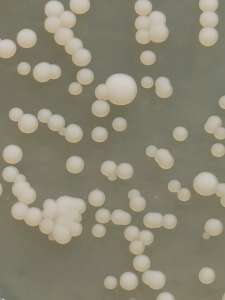A work carried out by researchers from the Millennium Institute BASE and the Microbial Ecology Laboratory (LEMi) of the University of Chile and which seeks to contribute to the description and conservation of the biodiversity of the ecosystems associated with lichens in the Aysén region and the Magellan region.
April 6, 2023.- The largest collection of basidiomycete yeasts isolated from the thallus of Peltigera lichens and the first collection of yeasts associated with lichens from southern Chile, was published in the Global Biodiversity Information Facility (GBIF) by researchers from the Millennium Institute BASE and the Microbial Ecology Laboratory (LEMi) of the University of Chile, guided by Dr. Julieta Orlando.
The initiative was led by Yosbany Pérez, a doctoral student from the University of Chile and also a researcher at LEMi and the Millennium Institute BASE, who pointed out that the work carried out “provided evidence that lichens would act as a specific niche that harbors different microorganisms, including yeasts. Those that are currently considered a new essential component of the symbiosis of lichens. This helps to provide more information about the components of the lichen mycobiome and, therefore, to enhance the conservation of these microorganisms and the ecosystems that surround them.”
The collection studied comprises 180 basidiomycete yeasts isolated and identified from the thallus of four Peltigera lichen species (P. frigida, P. fuscopraetextata, P. rufescens and P. antarctica) collected in southern Chile, specifically in the Coyhaique National Reserve and the Patagonia Natural Park, Tamango sector, located in the Aysén region of General Carlos Ibáñez del Campo; and in the Karukinka Natural Park and Navarino Island, located in the Magallanes and Chilean Antarctic region.
This study is the first to describe the presence of basidiomycete yeasts in Peltigera lichens. A great diversity of genera of basidiomycetes was found, belonging to the classes Agaricostilbomycetes, Cystobasidiomycetes, Microbotryomycetes and Tremellomycetes. The phylogenetic analyzes carried out suggest the presence of species not reported so far, requiring additional biochemical and physiological studies to describe these potential new species.

Some basidiomycete yeasts reported in association with lichens have a lifestyle completely dependent on them, so it is highly probable that the lichen species studied are reservoirs of unreported yeasts. The identification of these new yeast species could have future applications in research, for example, in the field of biotechnology.
“It is very important for the entire scientific community that there be free access to these data, so that any research team that needs the information can consult and use it. This platform (GBIF) allows anyone to access the database and be able to think about other investigations”, indicated the data manager of the Millennium Institute BASE, Catalina Marín, who worked with the team in the publication of the data.
For her part, PhD. Julieta Orlando, Alternate Director and principal investigator of the Millennium Institute BASE, stated that “we are committed to ensuring that the information we generate reaches various audiences, since we believe that knowledge of the biodiversity of Antarctic and sub-Antarctic environments it must not only reach decision makers, one of our fundamental objectives, but also other scientific teams and the community in general.”
“We are convinced that, through this transfer of knowledge, it will be possible to generate the necessary awareness to protect the biodiversity of these environments. In this sense, the publication of repositories of various organizations in GBIF is essential for us to make research data easy to find, accessible, interoperable and reusable (FAIR principles)”, added the director of LEMi.
The team was also made up of researchers from LEMi and the University of Chile: Nayla Serey, Natalia Lizana, Katerin Almendras and Juana Leal; and by the academic from the Department of Biology, Geology, Physics and Inorganic Chemistry of the Rey Juan Carlos University (Spain), Ana María Millanes.
Find the collection here https://doi.org/10.15468/hw7k9r
Main picture: Peltigera lichens by M. Insitute BASE/ Julieta Orlando

